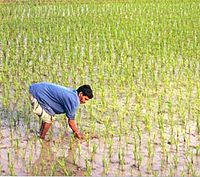
Photo from wikipedia
PurposeThe concept of irrigating crops with saline irrigation water is not new, but impacts of this practice on soil properties remain debatable, particularly the use of highly saline water. In… Click to show full abstract
PurposeThe concept of irrigating crops with saline irrigation water is not new, but impacts of this practice on soil properties remain debatable, particularly the use of highly saline water. In this work, key soil chemical properties were assessed to a depth of 300 cm following 2.5 years of application of highly saline irrigation to a sodic texture-contrast soil (Brown Sodosol) in south-eastern Tasmania, Australia.Materials and methodsControl plots (rainfall only) were compared to irrigation treatments of low (0.8 dS/m) and high salinity (16 dS/m) waters at application rates of both 200 and 800 mm/year.Results and discussionWhilst significant increases in both electrical conductivity and chloride concentration occurred throughout the soil profile in the high salinity treatment, these values were well below those of the irrigation water, indicating effective deep leaching. In the upper soil profile, 0–50 cm, of the high salinity treatments both the exchangeable Na+ and its ratio to total base cations (ESP) were significantly increased whilst the lower soil profile between 50 and 200 cm, was improved via both reduced alkalinity and sodicity. Leaching of the exchangeable base cations Ca2+, Mg2+ and K+ was significant in the upper soil profile (0–50 cm). As expected, the low salinity treatment (0.8 dS/m) had minimal impacts on soil chemical properties. The upper topsoil (0–10 cm) total organic carbon was significantly reduced in the high salinity plots and was negatively correlated with Cl− concentration.ConclusionsThe data confirms the general concerns about application of saline irrigation, namely increased whole profile salinisation and upper soil profile (0–50 cm) sodicity, but they also show unexpected and desirable reductions in the lower soil profile (> 50 cm) alkalinity and sodicity. It appears the Na+ ions present in the saline waters led to differential leaching of base cations from the rooting zone, especially Ca2+ which then ameliorate the alkalinity and sodicity deeper in the soil profile (> 50 cm). Thus, surface application of gypsum may help sustain the application of highly saline waters; alternatively, subsurface irrigation above the sodic clayey subsoils could be trailed.
Journal Title: Journal of Soils and Sediments
Year Published: 2018
Link to full text (if available)
Share on Social Media: Sign Up to like & get
recommendations!